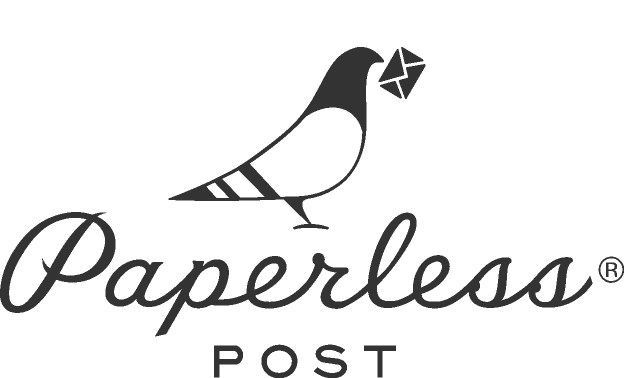A stress-free guide to creating an event budget
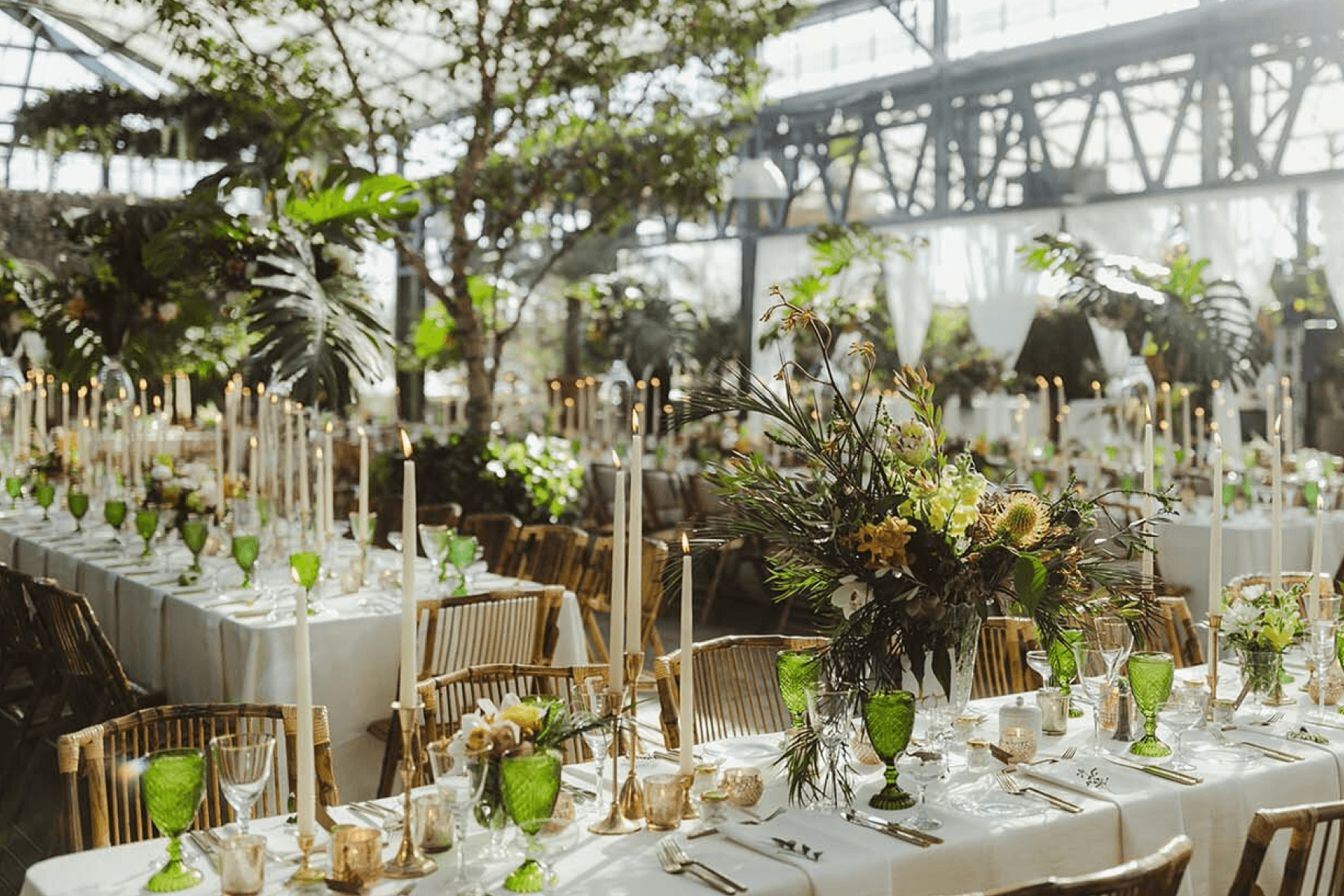
Whether you’re hosting an unforgettable corporate fundraiser or a sweet baby shower in your home, every kind of party needs a budget. Tracking your expenses helps you save on event costs, negotiate with vendors for the best rates, make attendance more affordable for guests, and prioritize the most important details to create the best possible party for the occasion.
Event budgeting may not feel as glamorous, memorable, or fun as the event itself, but a fiscally conscious plan takes the stress out of the planning process so you can enjoy it when the day finally arrives. So how do you plan an event budget—and how do you stick to it?
Table of Contents
How to create an event budget
Anything is possible for your party—as long as it fits in your budget. To create your budget, consider the following:
- For corporate events or fundraisers, your budget may have been approved long before you were assigned to plan it, but it’s still the number you’ll have to stay under. If you’re planning on earning funds from ticket sales, donations, or sponsorships, incorporate those into your bottom line.
- For smaller, private events, determine how much you and your fellow hosts can comfortably spend on the event. Keep in mind that if the event has a guest of honor, they shouldn’t be asked to contribute to the cause.
- Divide your now-established budget into sections, and track spending—spreadsheets make this process straightforward and easy.
- Add categories for each expense in your budget, such as food, entertainment, and venue. Include the maximum budgets for each item—when they’re added together, they shouldn’t exceed your initial budget.
- Determine your time frame for the event. How far in advance do you need to book catering, and when will the venue require a deposit?
- Come up with alternatives for items that fall outside your budget. For example, if catering is too expensive, maybe your upcoming birthday dinner can be a potluck.
9 expenses to include in an event budget
Creating an event budget starts with itemizing every potential expense your party may incur. List it all out, from the smallest expenses to the biggest-budget items, to get as near to the actual cost as possible.
Below is an event budget template with some expenses to consider as you’re planning your party, along with more information about each category.
Sample event budget
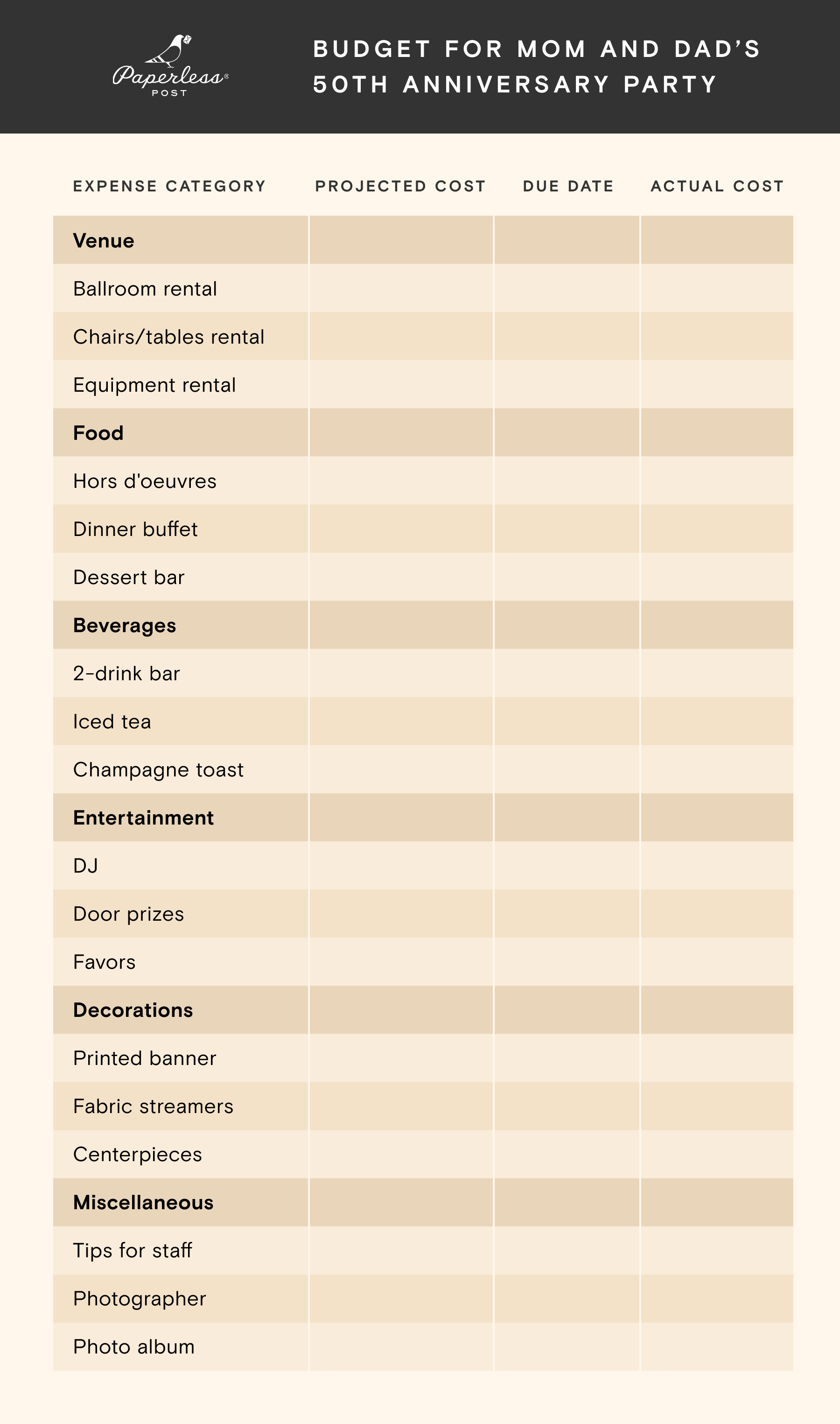
1. Venue
No matter how humble or extravagant it is, every party needs a venue, which is generally one of the costliest party-planning expenses—especially if you’re hoping to book a large, popular location during peak season.
The expense of renting out a venue varies with the type of event you’re hosting. For example, a birthday party venue may range from $100 to $500, while a large space for a corporate event might cost closer to $2,000.
Here are some important details to keep in mind when choosing a venue within your budget.
- Venue type: A large hotel ballroom will be much more expensive than a private room in a restaurant.
- Location: If you’re planning an event in a big city or a resort town, the venue may be pricier than a local party.
- Season: Some venues are more expensive in seasons when demand is high, like beach towns in the summer or skiing areas in the winter. Their rates may come down significantly in less popular seasons.
- Day of the week: Venue rental rates for weekend events tend to be more expensive than those for events in the middle of the week.
- Length of rental: Renting a venue for the whole day could cost more than renting it for the evening—although you may have a better selection of dates if you’re willing to book more time.
- Furniture: Many venues and caterers include dining room set-ups in their rates—but you may need to rent extra furniture to make every guest feel comfortable.
- Accessibility: Don’t forget to take event accessibility under consideration—shuttles, parking, or late-night rideshares can all factor into your final bill.
While location-related expenses can be steep, many spaces offer party packages to cut down on costs in other areas. Either way, plan to reserve the largest portion of your budget for your venue, unless you’re planning on hosting at someone’s home for free.
2. Food and beverages
Even the best event can be a dud if the food and drinks aren’t good—or worse, if there’s not enough. Feed your guests and stay on budget with these considerations.
- Meal or appetizers: Are you serving a full meal, or will hors d’oeuvres suffice? If your event falls during a typical mealtime, consider a plated or buffet meal.
- Catering: While you might DIY the fare for smaller parties, catering can be another costly expense for large events. For example, the average wedding catering clocks in around $20–$75 per person—not including the bar. As an affordable alternative, consider hiring a food truck, which has become a trendy alternative in recent years and averages between $8 and $30 per head.
- Dietary accommodations: Ask vendors whether they charge extra for accommodating dietary restrictions and allergies.
- Open bar or no-host bar: Will you host an open bar, provide a set number of drink tickets for every guest, or expect attendees to pick up their own tabs? Open bars, where the host pays for unlimited drinks, can account for up to 20% of a party’s total costs.
- Vendor meals: DJs, photographers, and party planners need meals, too. Factor them into your headcount—and plan for the moments when they won’t be working.
- Dry events: Plenty of events exclude booze altogether, so let your guests know ahead of time what to expect in your party invitations. Depending on the crowd, this could be a wise cost-cutting option.
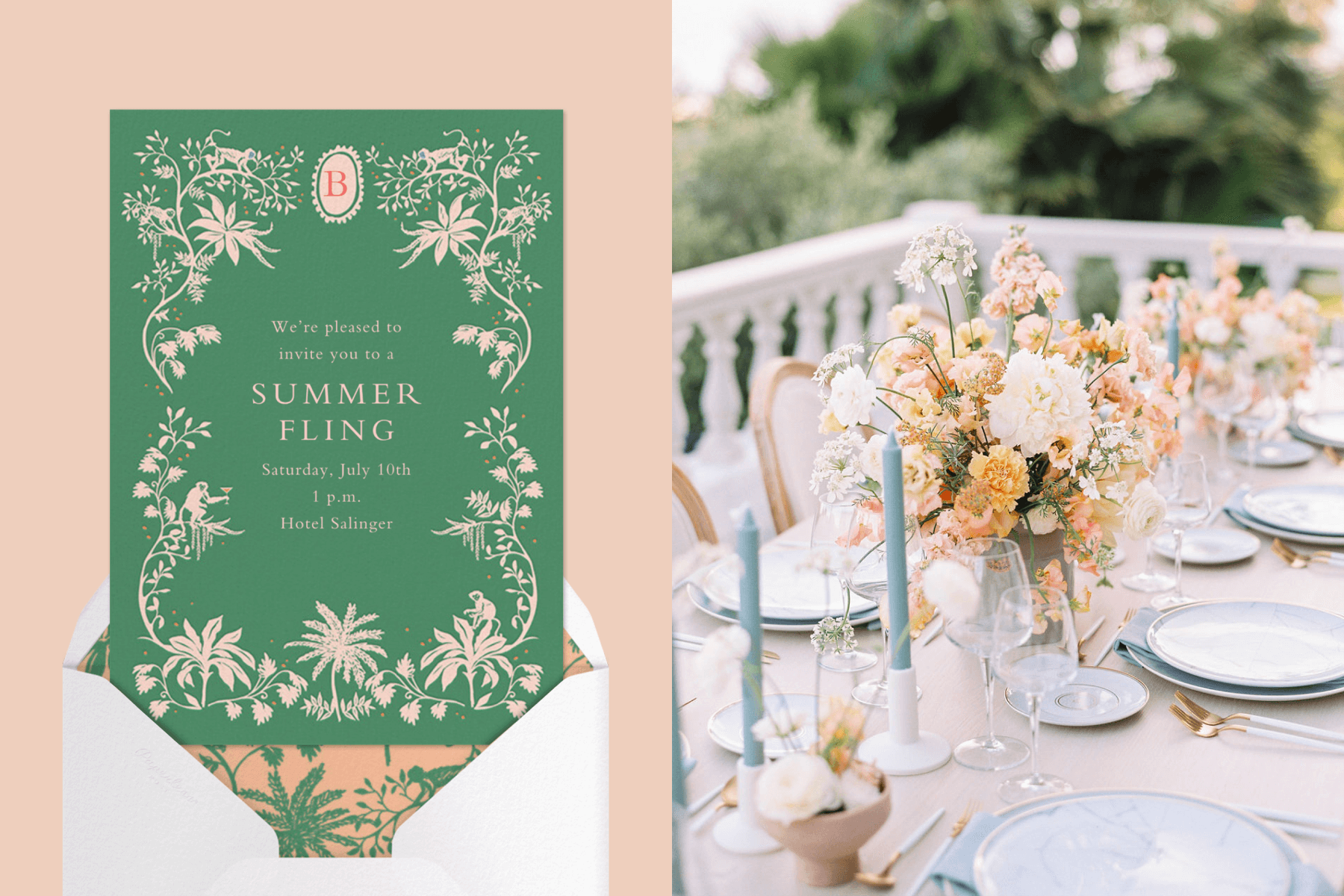
3. Decorations
Balloons, lighting, floral arrangements, and other fun details set the tone for your event and bring the room together. But it’s easy to get swept away if you don’t keep an eye on your budget, so consider the following before you dig into decor:
- List your dream decor: If money were no object, what experience would your guests have? Jot down every feature of your vision, from floor to ceiling, including decorations. Think of the sights, sounds, and textures you want your guests to encounter upon arriving.
- Whittle down your list: Identify which parts of this dream are the core elements that drive your theme the most. For instance, if you envision a live string quartet at your anniversary dinner, you won’t need to budget for a DJ and A/V equipment.
- Have a plan B—and get creative with it: Every host ends up having to make some compromises, whether it’s because you’re booked out of your dream location or due to a summer storm. Zero in on your event priorities—with a little ingenuity, you can conjure the same magic you originally envisioned without watching the costs climb. Can’t afford an ice luge for your winter wonderland party? Buy some tall glass vases, fill them with ice chips, trim them with string lights, and stage it all by the cocktail bar for a sparkling substitute.
4. Event technology and tools
To get the best rates on technical equipment for your party, think about the moments or portions of your event that need A/V support. Many A/V vendors offer package deals for specific event types, like graduations or corporate dinners. It’s also worth dropping a line to your chosen venue to ask if they have a referral or approved list of vendors for you to work with.
Some common tech and tools needed for events include:
- PA systems: If your event is an award ceremony, involves speeches, or requires a DJ, you’ll need a microphone and PA system at the venue. The rental cost can get higher if you’re planning on live music performances—it means more microphones and speakers.
- Projection stands and screens: Slideshows and presentations require a place to project their images, so you’ll need to consider the cost of renting a screen and projection equipment.
- Lighting: Most venues have standard lighting included in their rental cost, but if you’re looking for party lighting with lots of colors and a logo projected onto the dance floor, that will cost extra.
5. Event invitations and other stationery
The larger the event, the steeper the cost of traditional print invitations. Paper wedding invitations can escalate to $1,800 for just 100 invitations—and that’s excluding save the dates and thank you cards.
Online event invitations are a budget-friendly alternative to old-school paper invites. You can set the tone of your event with fully customizable invitation options and send them via text, email, or shareable link. Take the headache out of collating responses and follow-ups with RSVP tracking and other included guest management tools.

6. Marketing and promotion for ticketed events
If you’re hosting a ticketed event, marketing costs are a pivotal part of your budget. To draw a crowd, you have to get the word out—and you have to know where your potential guests are. Add a Link Block on any Paperless Post invitation to let guests know your party requires a cover, and offer them a one-click route to make their purchase.
Weigh your overall event investments against your projected ticket sales. Event marketing investments typically include:
- Advertising: Whether it’s paper ads or online Flyers, consider the cost of advertising your event to the public.
- Social media marketing: Marketing on social media is an efficient way to get the word out—if you’re well-versed in it. Part of your budget might include the cost of a marketing expert who can get your invitation more impressions on various social media platforms.
- SEO services: Likewise, you may need to hire an SEO consultant to get your event optimized in search engine results.
- Event swag: Hats, shirts, napkins, pens—there’s no swag your guests won’t love. Put your organization’s name on everything, and of course, include the cost in your budget.
Once you’ve established your promotional expenses, draft projections for how much you expect to make in ticket sales, raffles, or other fundraising methods on your agenda.
7. Staff
Depending on the size and type of your event, you may need to budget for gratuity or hire extra staff. For a small birthday party, that may mean extra tips for servers or venue staff. But for major events, you may need to expand this part of your budget for one or more of the following vendors:
- Security: Some venues provide security as part of their fee, but if you need extra coverage—or you’re hosting a well-known person—consider hiring outside security.
- Party planners: If you’re using a party planner to help you organize the event or run it, include a line item to pay them—with gratuity for a job well done.
- Waitstaff/servers: Most venues include the cost of wait staff and servers when you book them—but for very large events, you may need to pay for extra coverage.
- Bartenders: Does your venue pay for a bartender during your event, or are you expected to provide one? Either way, budget for their hourly rate as well as a large tip.
- Photographers or photobooth: Don’t leave the photos to your guests and their smartphones. Hiring a photographer gives you images that you can use to advertise the next event, which is a nice way to save on your yearly event budget.
- Videographers: While not always required, hiring a videographer can capture the vibe of your event in a way that photographs only hint at, and you can use the footage to promote the event next year.
- Entertainers: If you’re hiring DJs, musicians, comedians, magicians, or special speakers, they’ll need a place in your budget as well. Famous entertainers may also require travel and board as part of their contract.
8. Favors and other fun stuff
Now that the key elements of your party are accounted for, you can decide whether you have any room for extras. Additional touches can make a party even more special. Some examples include:
- Branded gear to wear at the event: It’s advertising in real time—chances are, guests will rewear these T-shirts and hats, providing you with year-long marketing.
- Party favors like monogrammed wine glasses, pens, or magnets: Guests love stuff they can keep, especially if it’s something they can use. Buying these items in bulk can help you maximize your budget.
- Sweets and treats to take home after the fun is over: If you can get a good deal on prepackaged cookies or candies, buy a lot, and hand them out after the event.
- After-party expenses like transport, drinks, and late-night snacks: Never underestimate the cost of the after-party—and secure a place for it in your budget.
9. Unexpected costs
No matter the size of the party, your budget should have extra margin to make room for unforeseen circumstances. Unanticipated costs come with the territory, which is why many venues require you to purchase liability insurance for major events. While a birthday party might not need a large emergency budget, some bigger corporate events could need more money set aside for hiccups.
Most event planners suggest saving 10% of your total budget for these emergencies. When a shuttle bus doesn’t show up, the bartender calls in sick, or the bachelorette needs an emergency outfit replacement, you’ll be glad you added the padding. But the money is only part of your emergency planning—reserve backups for entertainment or food so you have options in place if you need them.

A budgeting guide for every party type
Each celebration is unique, but there are key costs associated with certain types of parties that you’ll want to account for in your event budget.
How to make a company party budget
For corporate event planning, you’ll probably have a capped budget to work with. Once you know your ceiling, there are a few primary costs you need to account for—price ranges depend on location and time of year.
- Venue: $100–$1,000 per hour
- Catering: $10–$100 per person
- Invitations: $100-$500
- Tech and equipment: $200–$1,000
Entertainment: $50–$500 an hour, depending on the entertainer
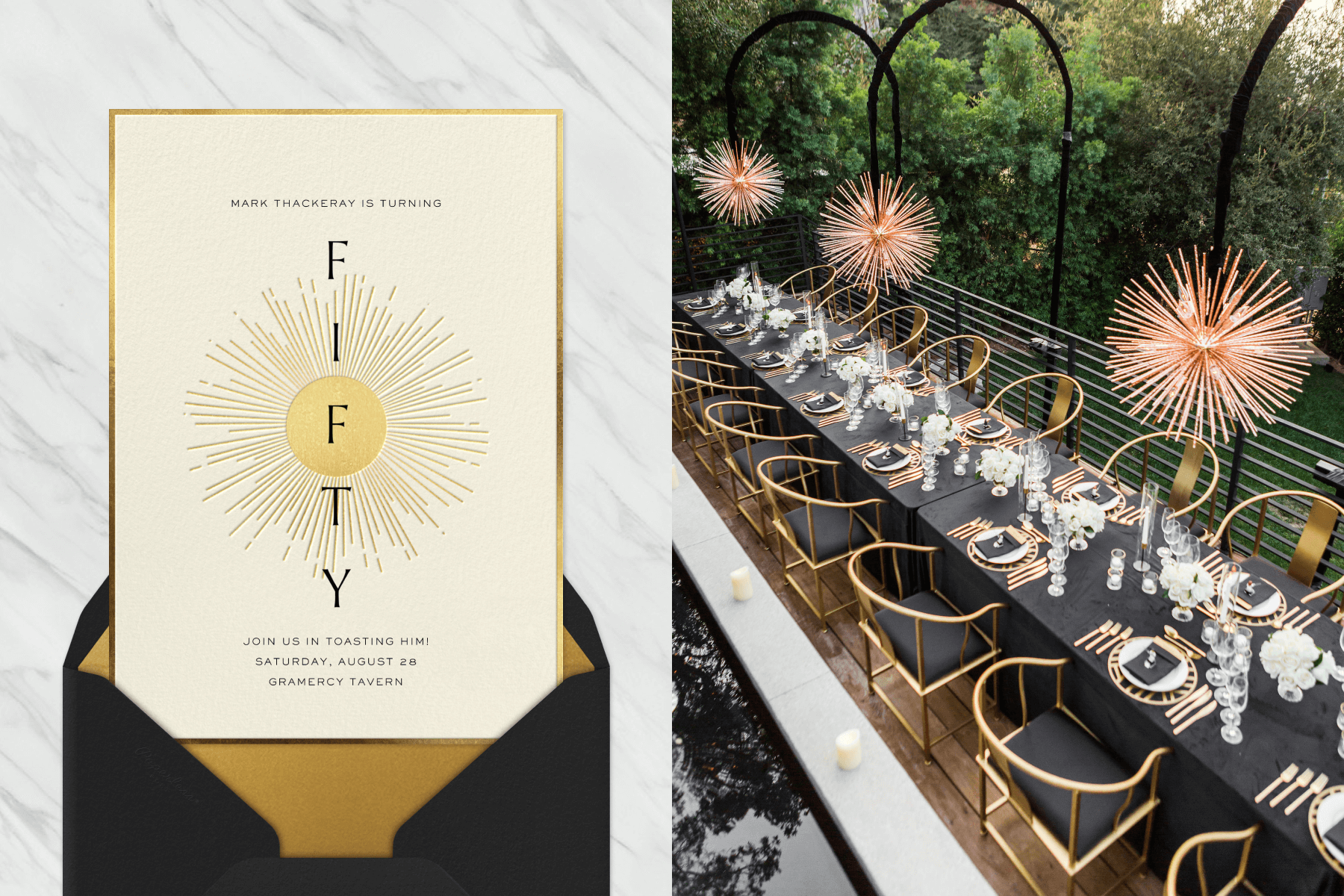
How to make a birthday party budget
Like most events, birthday party budgeting depends on the size and type of event you’re holding. Milestone birthdays, like quinceñeras, sweet sixteens, 21st birthdays, and 60th birthdays, have their own unique elements to plan and budget for.
When planning a birthday party on a budget, each decision you make should revolve around what will make the guest of honor feel extra special—and what you can afford.
- Venue: $50–$200 per hour
- Snacks or catering: $5–$20 per person
- Alcoholic and non-alcoholic beverages: $5–$20 per person
- Birthday decor: $20–$200
- Birthday cake or cupcakes: $10–$150
- Activities or entertainment: $0–$200
- Invitations and thank you notes: $20–$75
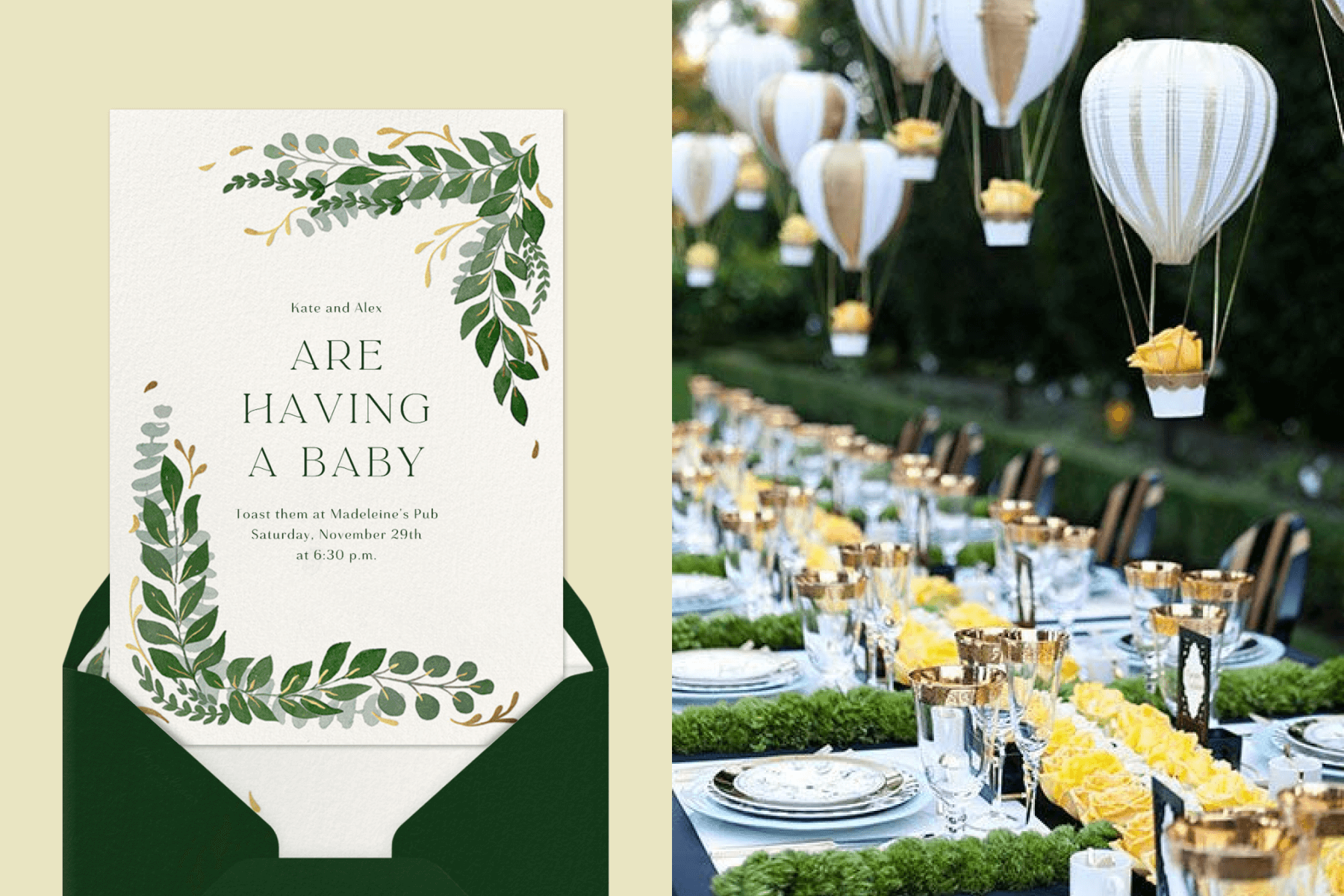
How to make a baby shower budget
Baby showers tend to have guests of all ages and from all walks of life who are close to the baby’s parents. In general, a baby shower is held at the home of the host, but it can also take place in a tea room, small banquet hall, or restaurant. Include these line items to plan a baby shower on a budget:
- Venue: $50–$200 per hour, if needed
- Hors d’oeuvres or light fare: $5–$20 a person
- Alcoholic and non-alcoholic beverages: $5–$20 a person
- Baby shower decorations: $20–$200
- Baby shower invitations: $20–$75

How to make a bachelorette party budget
Many bachelor and bachelorette parties are held out on the town, or at a single location where guests can celebrate all weekend long. An event budget can help you narrow down your choices. If it’s too expensive to transport attendees long-distance, consider hosting a small local party for in-town guests and those willing to travel.
The main attraction here is the activities, which means planning a bachelorette party on a budget should account for things like:
- Food: $20-$200 per person
- Beverages: $20–$100 per person
- Transportation: $20–$500 (this can vary widely for destination parties)
- Bachelor or bachelorette party-themed decor: $10–$100
- Bachelor or bachelorette regalia (e.g., crowns, boas, and drinkware): $10–$100
- Hotel bookings: $100–$500 a night
- Invitations: $20–$75
Tips for staying under budget
Once you add all your projected expenses to your spreadsheet, it may seem impossible to stay within your budget. But it’s easier than you think—especially if you have the right mindset. Here are some tips to help you stay within your budget without feeling like you have to make too many compromises.
Create two budgets: the dream party and the realistic party
Plan for what you or the guest of honor really wants—from celebrities and limos to caviar and Champagne. Then, create a second budget with as many backup plans as possible. Instead of top-shelf Champagne, would the house sparkling wine work? Could you exchange the limo for a nice Uber?
A smaller guest list means you can spend more
Most event expenses are calculated “per head,” meaning that inviting fewer guests lowers your overall cost. You might be able to splurge for that dream venue or entertainer if your guest list goes from 300 to 120 people.
Find freebies everywhere
Find the line between spending every cent of your budget and getting your friends to DIY the whole thing. If one friend loves making cupcakes, see if they can provide services for a reduced rate. If your aunt loves throwing parties at her large house, ask if she’d consider hosting your friend’s shower.
Track each expected and unexpected expense
If you plan to turn a profit, create 12-month, six-month, and one-month forecasts of your projections. Not only will it be easier to keep expenses under your budget ceiling, but you’ll also walk away with a blueprint to help you streamline the budget for any future events you organize.
Keep a flexible attitude
Once you know your budget cap, it’s easier to decide where you want to loosen or tighten your belt with respect to expenses. Each celebration will come with trade-offs as you plan your party. Just remember: your guests have lower expectations than you do as the host, and they’ll have a good time no matter what.
Build your budget, and host confidently with Paperless Post
Reduce the stress and expense of mailing paper invitations, and send elegant online invitations from Paperless Post instead. Our best-in-class invitation designs are easy to customize and include tools like RSVP tracking and guest messaging, as well as guest management features like Guest Tags, Guest Check-in, Guest Surveys, and more to streamline your planning process. Best of all, they’re fun, affordable, and won’t get lost in the mail.
